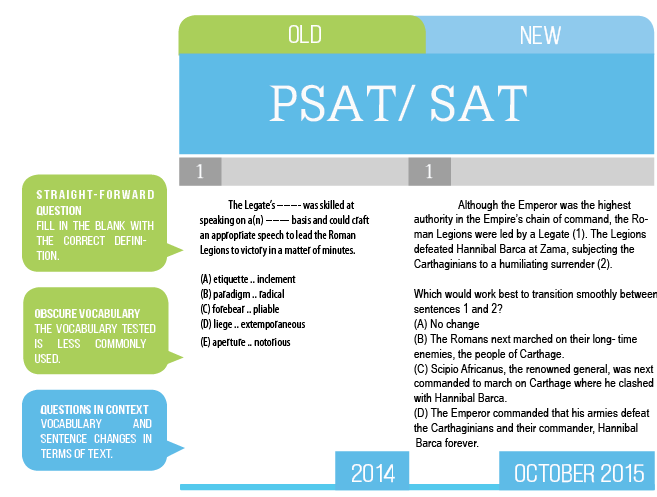Story by Bill Cheng and Jessica Xing
The PSAT, also known as the National Merit Scholarship Qualifying Test, was created to help students prepare for its scarier older brother — it’s a practice round for students to familiarize themselves with the concepts and formatting of the SAT, which is different enough to potentially throw off first-time test takers.
And now the PSAT, come October, will be the first official preview to students of the new SAT in March 2016.
The New PSAT/SAT
The SAT has a notoriously bad reputation, according to a New York Times article, due to its confusing questions and reliance on obscure, untaught content and expensive preparatory classes. College Board President and CEO David Coleman addressed these comments in March 2014 by announcing the new SAT’s changes set to take place in March 2016.
“No longer will it be good enough to focus on tricks and trying to eliminate answer choices,” Coleman said in an interview with CNN. “We are not interested in students just picking an answer, but justifying their answers.”
“Justifying their answers” has become a repeated phrase, a tagline for the current education reform. First launched in America in November 2009, Common Core plays a big role in the new features of the PSAT/SAT — the education system is evolving to test students’ ability to connect information back to a bigger picture instead of rote memorization of facts.
SAT prep classes, their cost and their purpose, is another main criticism of the old format. While on the topic of memorization, students, with prep classes, can get a higher score by memorizing the “tricks” Coleman mentions.
Coleman, in an attempt to fix this issue, has decided to form a partnership with Khan Academy, an online school that offers free preparatory material for students, even offering some income-eligible students free registration for four colleges of their choice. By changing the format of the PSAT/SAT, Coleman hopes to discourage the current trend of students using tricks and hacks to get them the highly sought after 2400.
Changes in preparation
There has been a lot of talk about what is changing and what is not. Calculus AB teacher Martin Jennings has been teaching extracurricular PSAT/SAT classes at MVHS for the past eight years.
“Our resources are going to change,” Jennings said. “[I’m] not sure what we’ll be using for the SAT, but the PSAT book we use is already in the new PSAT format.”
The PSAT takes about six days to cover, and the general principles will be staying the same, according to Jennings.
“There’s a lot more statistics,” Jennings said. “Graph interpretations. So, that will be reflected in the materials we’ll use to prepare. The same strategies will still be involved, though.”
Although classes are the most popular way to prepare, some students have taken to self studying. Because of her tight schedule, sophomore Krithika Rao prefers to study at her own pace. She studies about two hours on Saturday and two hours on Sunday.
“Usually I just have a book and then I time myself using the timed tests [and] an alarm on my phone,” Rao said, “and then I just take the tests and after that I see what I got wrong and I correct myself. For vocabulary, I have Quizlet sets on words that I need to work on.”
Finding the time and motivation to study for the PSAT can be hard for Rao because she has to factor in homework, daily swim practice and study for regular tests during the school year. However, Rao likes the system she has because of the control she has over her own pace. With her study style down, Rao can now choose to study for the PSAT or the old SAT.
“Right now I’m mostly studying for the PSAT,” she said. “I heard the new SAT is more Common Core based, and it’s more in terms of content. I don’t like it as much.”
Sophomores are most likely to be affected by the new SAT, which is why many are taking the PSAT this year to familiarize themselves with the format.
“The PSAT is a good starting point, especially in junior year when you have to take the NMSQT [National Merit Scholarship Qualifying Test],” sophomore Jen Huang said. “It is the same thing, so you might as well get used to it, especially since it is new this year.”

A second chance at the PSAT
Huang took the PSAT as a freshman at her old school, and then later took a practice test for the new PSAT at a separate site.
“The timing is different,” she said, “and the main difference is the reading. You don’t go back and reread the passage — you read the passage and the questions are happening while you are reading.”
Juniors, on the other hand, have the privilege of being stuck intween — there’s a lot of uncertainty surrounding the new SAT, leaving many juniors rushing to squeeze it in the fall before it changes. Yet, despite the overwhelming popularity of the old test, many are still signing up to take the PSAT this year.
“I’m taking it specifically for the scholarship,” junior Vincent Huang said. “But I’m taking the old SAT because you know what’s going to be on the test. No one knows anything about the new SAT for sure.”
There are also juniors who, despite taking the old SAT, still want to use the PSAT as practice, or as a way to gauge future options.
“I want to first try it out,” junior Maneesha Kanukuntla said. “If I like it I might take the new SAT.”
Although sophomores and juniors are both trying to adjust to the changes, both agree that the new practice test gives a more holistic preview of what March 2016 has in store for future test takers.







